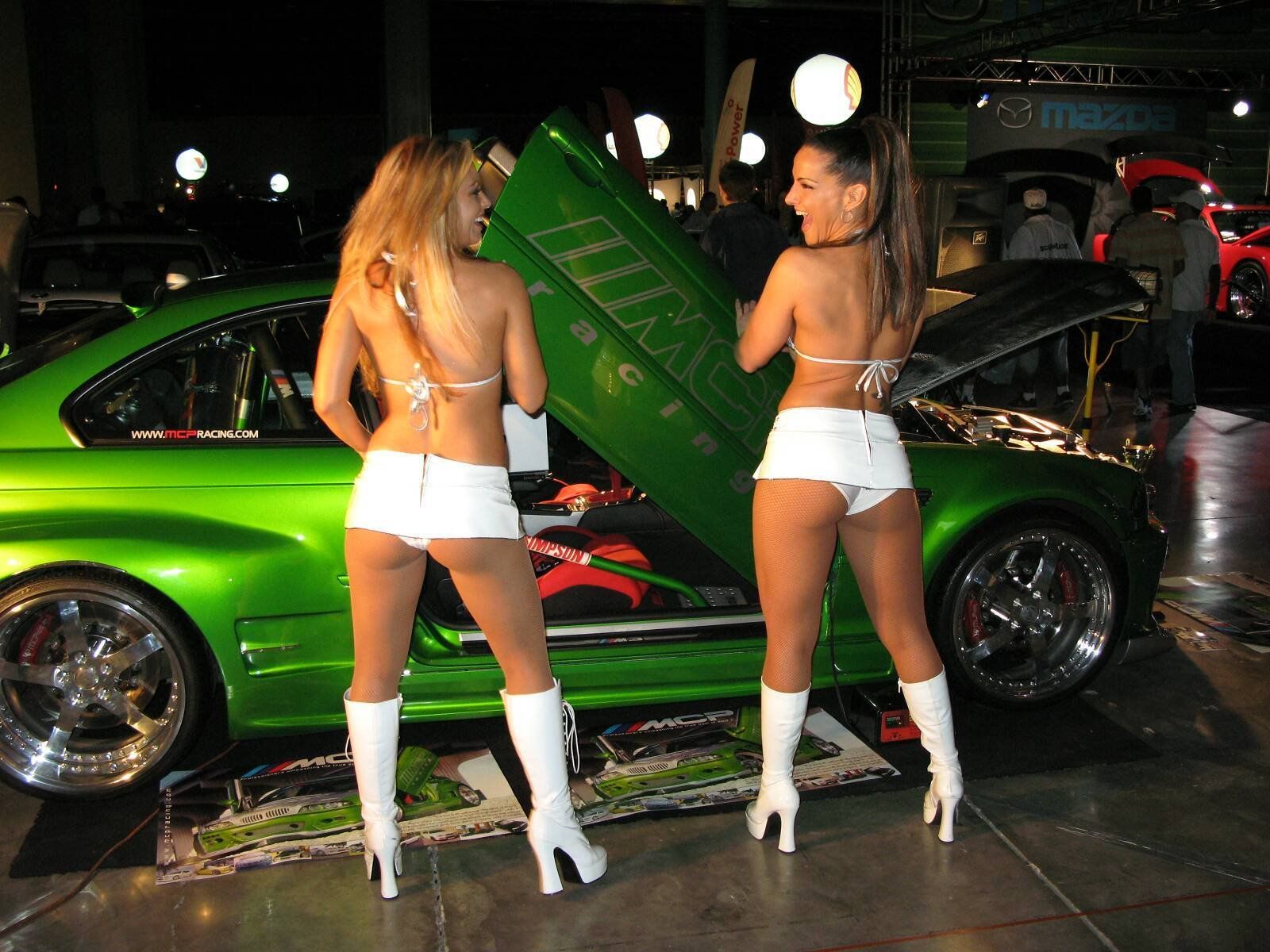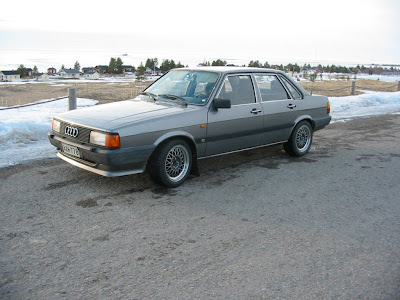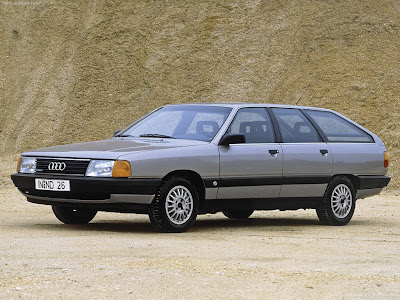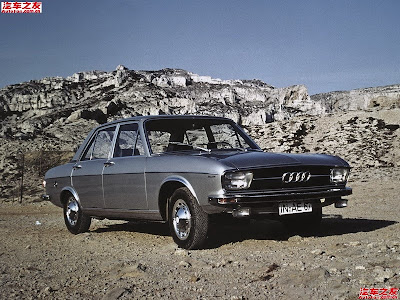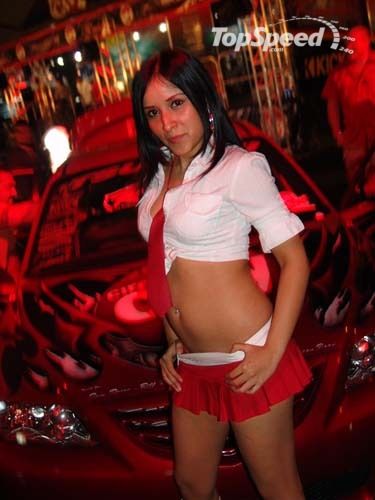|
|
|---|
Sunday, October 11, 2009

Quattro (meaning four in Italian) is the name used by Audi AG to indicate that four-wheel drive (4WD) technologies or systems are used on specific models of the Audi automobiles.The Audi V8L quattro made by Audi AG of germany in 1989 and was the first Audi to use its namesake engine configuration. History Although the vehicle was based on VW/Audi's existing C3 platform (namely the 100/200 sedan), the V8 model featured standard quattro all-wheel drive and a 32 valve, DOHC V8 engine with either a five-speed manual or four-speed electronically controlled automatic transmission, giving it the power and road-holding ability to match the V8 powered offerings from BMW and Mercedes-Benz. The V8 closely resembled the 100 and 200 models, although a unique grill design, extended wheelbase, pronounced wheel arches and larger wheels helped distinguish it. Much attention was lavished on the vehicle's new engine, although the V8 was also significant in that it was the first production Audi to combine the quattro system with an automatic transmission. The 3.6 L (3562 cc) powerplant was essentially two four-cylinder engines which had been mated at the crankshaft to form a V8. In this case it was the Volkswagen Golf GTI's 1.8 L, twin cam, 16-valve inline 4-cylinder that provided the starting point. Power output was very strong for the day, with 250 PS (184 kW/247 hp) and 340 N·m (251 ft·lbf) of torque available over a fairly wide powerband. Audi introduced a long wheelbase version in 1990 and in 1991 made a 4.2 L (4172 cc) powerplant with 280 PS (206 kW/276 hp) and 400 N·m (295 ft·lbf) available. Like the base model, it had standard quattro and an optional automatic transmission, but a six-speed manual gearbox replaced the 5-speed of the 3.6 model. The car's base price in 1994, its final year of production, was US$58,700. Motorsport Audi developed a Group A competition version of the V8 for entry into the DTM (German Touring car Championship) and began racing with it in 1990 with Schmidt Motorsport running the operation and Hans-Joachim Stuck, Walter Rohrl and Frank Jelinski driving. Stuck won the title, and the following year Audi added a second team to the mix, Audi Zentrum Reutlingen. SMS continued with Stuck and Jelinski, while AZR raced with Frank Biela and Hubert Haupt. Biela gave Audi another crown in 1991, but was unable to defend the title in 1992. After that season, the DTM organizers deemed the V8's crankshaft illegal and Audi retired from the championship.
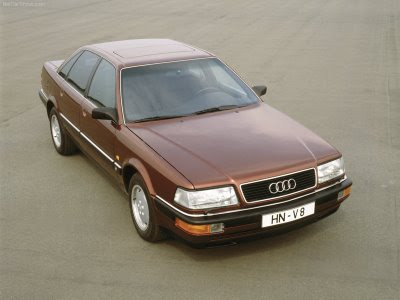
The Audi V8 was a large luxury sedan built by Audi AG of Germany from 1988 to 1994 as the company's range-topping model, and was the first Audi to use its namesake engine configuration. It was replaced by the A8 in 1994, though the A8 would not be sold in North America until the 1997 model year. History Although the vehicle was based on VW/Audi's existing C3 platform (namely the 100/200 sedan), the V8 model featured standard quattro all-wheel drive and a 32 valve, DOHC V8 engine with either a five-speed manual or four-speed electronically controlled automatic transmission, giving it the power and road-holding ability to match the V8 powered offerings from BMW and Mercedes-Benz. The V8 closely resembled the 100 and 200 models, although a unique grill design, extended wheelbase, pronounced wheel arches and larger wheels helped distinguish it. Much attention was lavished on the vehicle's new engine, although the V8 was also significant in that it was the first production Audi to combine the quattro system with an automatic transmission. The 3.6 L (3562 cc) powerplant was essentially two four-cylinder engines which had been mated at the crankshaft to form a V8. In this case it was the Volkswagen Golf GTI's 1.8 L, twin cam, 16-valve inline 4-cylinder that provided the starting point. Power output was very strong for the day, with 250 PS (184 kW/247 hp) and 340 N·m (251 ft·lbf) of torque available over a fairly wide powerband. Audi introduced a long wheelbase version in 1990 and in 1991 made a 4.2 L (4172 cc) powerplant with 280 PS (206 kW/276 hp) and 400 N·m (295 ft·lbf) available. Like the base model, it had standard quattro and an optional automatic transmission, but a six-speed manual gearbox replaced the 5-speed of the 3.6 model. The car's base price in 1994, its final year of production, was US$58,700.
Labels: Audi, auto, Car Prices, engine, gti, luxury cars pics, model, speed, Wallpapers, wheel
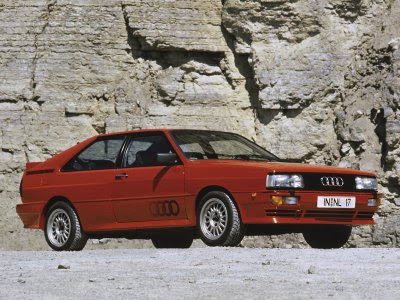
The Audi Quattro was a famous and historically significant Audi road and Rally car. It was special in that it was the first AWD Grand Tourer since 1966's Jensen FF. Officially, the model name is simply "Quattro", always with a capital "Q" (although the graphics on the car, confusingly, refer to the AWD system and use a lowercase "q"). The word "quattro" with the lowercase "q" is used to refer to either the Audi AWD system, or any AWD version of an Audi automobile. To avoid confusion, it is also commonly referred to as the Ur-Quattro (the "Ur-" prefix is a German augmentative used, in this case, to mean "original" and is also applied to the first generation of Audi's S4 and S6 sport sedans, as in "UrS4" and "UrS6"). European Distribution Audi released the original Quattro in 1980, making it both the first car to feature Audi's quattro All Wheel Drive system (hence its name) and the first to mate quattro with a turbocharged engine. The powerplant was a 2.1 L, single overhead cam, 10 valve straight-5 originally making 160 hp (149 kW) and eventually receiving upgrades to 200 hp and then to a twin-cam setup producing 220 hp (164 kW). It is considered one of the most significant rally cars of all time, and was one of the first to take advantage of the then-recently changed rules which allowed the use of all-wheel-drive in competition racing. Many critics doubted the viability of all-wheel-drive racers, thinking them to be too heavy and complex, yet the Quattro was an instant success, winning its first rally on its first outing. It won competition after competition for the next two years. Total road car production is around 11,000 vehicles over the period 1980-1991. The body style received very little modification during its production run, the only significant changes were made for the 1985 model year, which included a new sloping front grill, headlights, trim and badging changes. All Quattros were hand built in Germany by a dedicated crew. North American Distribution Sales of the Quattro in North America began with the 1983 model year and continued through 1986. Total sales in the USA was 664 units. The Audi Sport Quattro The Audi Sport Quattro was a Quattro program car developed for Group B rallying homologation, and sold as a production car in limited numbers it featured a different body shell and a significantly shorter wheelbase.
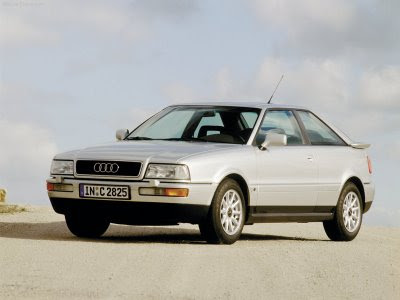
Labels: Audi, coupe, sebring, Wallpapers
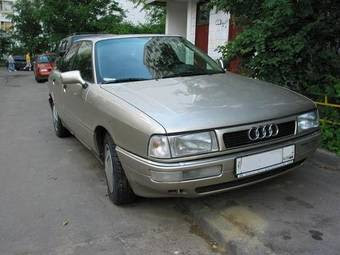
The Audi 80 is a compact executive car produced by the German car manufacturer Audi, from 1966 to 1996. It initially shared its platform with the Volkswagen Passat, and was available as a saloon car/sedan and an Avant (Audi's name for an estate car/station wagon). The coupé and convertible models were not badged as members of the range but shared the same platform and many parts. There were several different engine types, of which the petrol engines included the fuel-injected "E" (Einspritzung), and carburetor "S", and the diesel engines included "D" (diesel), "TD" (turbodiesel), or "TDI" (Turbocharged Direct Injection). In North America, the 80 was sold briefly as the Audi Fox and from 1980 to 1987 as the Audi 4000. The Audi 90 was an upmarket version of the Audi 80.
Labels: Audi, convertible, engine, model, Wallpapers
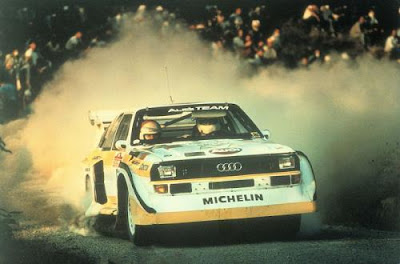

The Audi Sport Quattro S1 was introduced at the end of 1984 as an update to the Audi Sport Quattro. The car featured a inline 5-cylinder engine that displaced 2,110 cc (128.8 cu in) and produced an officialy quoted figure of 350 kW (480 PS/470 bhp). However, the turbocharger utilised a recirculating air system, with the aim of keeping the turbo spinning at high speed, and the actual figure was in excess of 500 bhp (373 kW/507 PS) at 8000 rpm. In addition to the improved power output, an aggressive aerodynamic kit was added that featured very distinctive wings and spoilers to the front and rear of the car to increase downforce. The weight was lightened to just 1,090 kg , and now accelerate from 0-100 km/h (62 mph) in just 3.1 seconds. Some of the cars were supplied with a "power-shift gearbox", which is said to be a forerunner of today's Direct-Shift Gearbox technology. The S1 proved to be an immediate success in the rally circuit, helping Walter Röhrl and Christian Geistdörfer win the 1985 San Remo Rally. A modified version of the S1, was also driven by Michèle Mouton. The S1 evolution would become the final Group B car produced by Audi, with the works team withdrawing from the Championship following the 1986 rally in Portugal. Twenty years after the cancellation of Group B, the Sport Quattro S1 was still widely regarded as the most powerful rally car ever fielded in international competition, with the final factory machines of 1986 rated at an incredible 441 kW. In addition to Group B competition, the S1 won the 1985 Pikes Peak International Hill Climb with Michèle Mouton in the driving seat, setting a world record time in the process. This victory was repeated in 1987, this time at the hands of Walter Röhrl, and again in 1988 and 1989 completing a hat-trick.
Labels: Audi, engine, quattro rally, RALLY, speed, turbocharger
Saturday, October 10, 2009
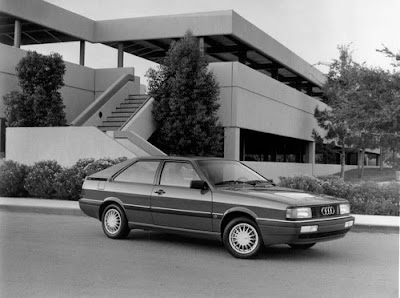
The Audi Coupe GT was a 2-door sports car produced and sold by Audi from 1981 to 1987. The car was an attempt by Audi to offer a more affordable version of its turbocharged, all-wheel drive Quattro. The Coupe GT featured a similar body shape to the Quattro, but without the knife-edged fender flares of the more expensive car. Mechanically, the biggest changes from the Quattro to the GT were the use of a naturally aspirated 5-cylinder engine and a front-wheel drive. The Audi Coupe range was fitted with the quattro All Wheel Drive system from late 1984 to produce the Audi Coupe quattro, a model which was rarer than the Turbocharged Quattro model.
Labels: Audi, coupe, engine, model, quattro rally, RALLY, sebring, Wallpapers, wheel

The Audi Sport Quattro was a Quattro programme car developed for homologation for Group B rallying in 1984, and sold as a production car in limited numbers. It featured an all aluminium alloy 2,133 cc (130.2 cu in) (2.1 L) 20v DOHC engine slightly smaller than that of the Audi Quattro (in order to qualify for the 3-litre engine class after the scale factor applied to turbo engines). In road-going form the engine was capable of producing 225 kW (306 PS/302 bhp), with the competition cars initially producing around 331 kW (450 PS/444 bhp). The vehicle also featured a body shell composed of carbon-kevlar and boasting wider arches, wider wheels (nine inches as compared to the Ur-Quattro's optional eight inch (203 mm) wide wheel rim), the steeper windscreen rake of the Audi 80 (requested by the Audi Sport rally team drivers for improved visibility) and, most noticeably, a 320 mm (12.6 in) shorter wheelbase. This was carried out in order to improve handling potential in the face of newer, smaller competition, such as the Lancia 037 and the Peugeot 205 T16, which had been purpose-built from the start for Group B rules.
Labels: Audi, engine, quattro rally, RALLY, Wallpapers, wheel
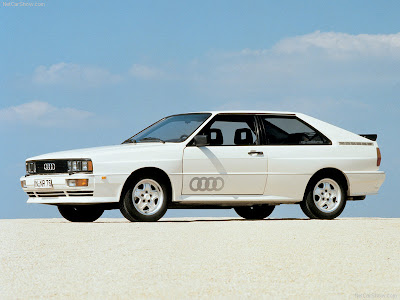
The Audi Quattro was a famous and historically significant Audi road and Rally car. It was special in that it was the first AWD Grand Tourer since 1966's Jensen FF. Officially, the model name is simply "Quattro", always with a capital "Q" (although the graphics on the car, confusingly, refer to the AWD system and use a lowercase "q"). The word "quattro" with the lowercase "q" is used to refer to either the Audi AWD system, or any AWD version of an Audi automobile. To avoid confusion, it is also commonly referred to as the Ur-Quattro (the "Ur-" prefix is a German augmentative used, in this case, to mean "original" and is also applied to the first generation of Audi's S4 and S6 sport sedans, as in "UrS4" and "UrS6"). European Distribution Audi released the original Quattro in 1980, making it both the first car to feature Audi's quattro All Wheel Drive system (hence its name) and the first to mate quattro with a turbocharged engine. The powerplant was a 2.1 L, single overhead cam, 10 valve straight-5 originally making 160 hp (149 kW) and eventually receiving upgrades to 200 hp and then to a twin-cam setup producing 220 hp (164 kW). It is considered one of the most significant rally cars of all time, and was one of the first to take advantage of the then-recently changed rules which allowed the use of all-wheel-drive in competition racing. Many critics doubted the viability of all-wheel-drive racers, thinking them to be too heavy and complex, yet the Quattro was an instant success, winning its first rally on its first outing. It won competition after competition for the next two years. Total road car production is around 11,000 vehicles over the period 1980-1991. The body style received very little modification during its production run, the only significant changes were made for the 1985 model year, which included a new sloping front grill, headlights, trim and badging changes. All Quattros were hand built in Germany by a dedicated crew.
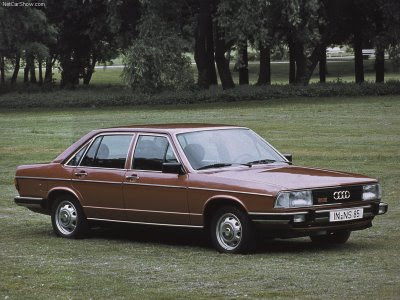
The Audi 100 was launched in 1976, with crisper styling and an unusual five-cylinder engine (the first gasoline 5 in the world - Mercedes-Benz had shown the way in 1974 with their three litre Diesel 5cyl in the Mercedes-Benz C111). It was initially a 100 bhp (74 kW) engine offering "5 cylinder power and 4 cylinder economy", and later upgraded to 136 bhp (100 kW). The Coupé was discontinued, but a five-door hatchback model, the 100 Avant, was launched as part of this generation. Two- and four-door models continued. The 100 was sold as the Audi 5000 in the United States, in order to rebrand the car and avoid association with the C1. It was a sales success, allowing Audi to spread development costs over a much wider base than Europe-only competitors. In 1980, the Audi 200, a plusher variant that included a turbocharged model of 170 bhp, available in 200 5E or 200 5T spec for the UK. The 5T or turbocharged model in addition of the 5E model featured heated seats, opening front quarter windows, cruise control, ski bag, green heat insulated glass, electric sunroof and elec heated mirrors. Available standard in 3 speed auto. The only options listed in the brochure were 5 speed manual transmission at no extra cost, air con and leather seating. This car was marketed in the US as the 5000 Turbo. The Audi 100/200 was succeeded by the C3 platform model in 1983, and the 200 followed one year later
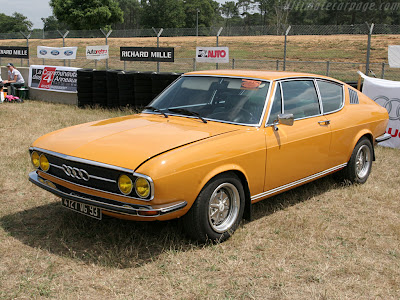
Labels: Audi, coupe, sebring, Wallpapers
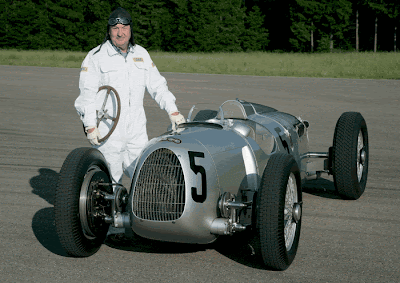
The Type-C was a third evolution of Auto Union's racecar. It primarily competed with Mercedes-Benz but also raced against Alfa Romeo's 12C-36, the Maserati V8RI and Bugatti 5950. Type-Cs won six victories in 1936 and made Bernt Rosermeyer world champion. Ferdinand Porsche designed the Type-C and championed his mid-engine design first used on the 1923 Benz Tropfenwagen. Weight distribution was his primary motivation in this choice. The driver could sit lower with no drive shaft and the front-to-rear weight distribution was more even. Furthermore, the fuel tank was also located centrally for balance. Despite these efforts, 60% of the weight still remained on the rear wheels. What made the car unbalanced was its heavy engine and comparably small chassis and body. The design team engineered the largest possible engine within the 750 kg weight limit. This resulted in the largest capacity engine to compete during 1936 and 1937. The chosen displacement was was six litres that was supercharged to achieve 550 bhp. A roots supercharger was attached to increase boost pressures up to 10 psi. The high power to weight ratio, uneven weight distribution and Porsche swing-axle suspension system made the Type C over steer. Drivers of the car had a hard time predicting slip velocity and the forward driving position made it worse. Only a couple drivers were able to take the Type-C to its full potential.
Labels: auto, blogspot, Bugatti Veyron, engine, RALLY, Used Car, Wallpapers, wheel
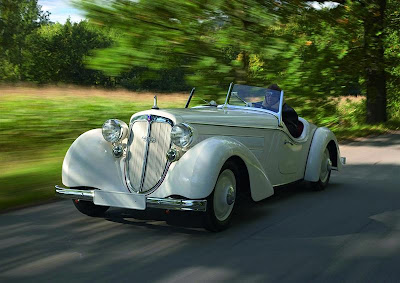
A special exhibition in the Audi museum mobile with the oldest surviving Audi models on display. The Audi museum mobile will be displaying no fewer than thirteen of the oldest Audi cars still in existence anywhere in the world. In order to present not only these historic vehicles but also any number of anecdotes from the company's early days in a stimulating manner, including the years up to the major interruption in its activities caused by the Second World War, the exhibition's organisers have adopted an unusual approach. The stories have become a storyboard, and this in turn takes the form of a comic strip. Each page deals with anecdotes, special occurrences and legendary landmarks in the Audi company's history. The choice of name, the dismissal of August Horch, the first eight-cylinder model, the pioneering adoption by Audi of left-hand drive in Germany, the competition for the first Audi radiator badge, acquisition by DKW and the subsequent creation of Auto Union – the chronicle continues until the point when, on the outbreak of war, Germany's second-largest automobile manufacturer had to cease production of passenger cars for the general public. As Stefan Felber from the Audi museum mobile explains: 'Audi's history is far too exciting for a conventional form of presentation. We have aimed to make it easily comprehensible at first glance, and for children to understand it easily too.' Car enthusiasts will welcome the chance to see outstanding examples from Audi's early history, above all the timelessly elegant Audi Front Roadster, on display for the very first time. Only two specimens of this prototype were built in 1935, and both have disappeared. Audi Tradition therefore supplied an original chassis to the specialist Zinke company in Zwönitz, which built a replica body with only photographs as a guide. Now this roadster, a 'dream in white', is making its world premiere at the Audi museum mobile. Another exceptional highlight is the Audi Type A, which dates from 1911. Exhibited for the first time at the company's head offices in Ingolstadt, this is the 78th car built by Audi in Zwickau and the oldest to have survived. This unique Type A, with its 26-horsepower engine, was capable of reaching 75 km/h. For the exhibition 'From Horch to Audi – The history of perfection has a new name', it has been loaned by the National Technical Museum in Prague –the first time, incidentally, that it has been made available in this way. The second-oldest exhibit, an Audi Type E built in 1913, also has a dramatic tale to tell. Its 55-hp engine, with a displacement of 5.7 litres, is the largest built by Audi during its Zwickau period. This model remained in production until 1924. Two examples are to be seen in the exhibition, one from the first and one from the final production batch. Although they have similar open tourer bodies, the changes introduced over an 11-year period can be clearly seen. The hero on the competition scene, however, is definitely the 'Alpine Victor' – the Audi Type C, built from 1911 to 1925. With August Horch himself as one of the drivers, this car won the Austrian Alpine Rally, at that time the most challenging event of its kind, three times in succession, the last occasion being in 1914. The car on display dates from 1919 and is still in roadgoing condition. Audi recorded a number of technical milestones in 1923 with the Audi Type M, in its day one of Germany's most luxurious and expensive cars. The engine had a light-alloy block and an overhead camshaft driven by a vertical shaft and bevel gears. An intake air cleaner was fitted. This Audi model was the first to have four-wheel brakes. The list price of 22,300 Reichsmarks was not within everyone's reach: Three of the 228 cars sold have survived, and also an additional chassis. The car on display is a sectioned model intended to illustrate the outstanding technical features and workmanship of the car. The Audi Type M was followed by the first Audi eight-cylinder model, the Audi Type R 'Imperator', which broke through the symbolic hundred-horsepower barrier. The car on display was built in 1929, and is the only remaining example of this model anywhere in the world. In 1931 Audi began to build the Type P, the first small car in the brand's history. For many years it was believed that none had survived, until 2003, when one was found in a barn in Ludwigsburg. Its documents indicated that the last owner had been the mayor of a town in the Swabian region of Germany and that the car had been taken off the road in 1955, to spend almost half a century like Sleeping Beauty waiting to be reawakened. Following extensive restoration in Riga (Latvia), Audi Tradition is now able to display this unusual car again – the sole surviving Type P. This first major Audi centenary exhibition is rounded off by cars produced by the Auto Union after its establishment and up to 1940 – two different Audi Front 225 models dating from 1935 and the last Audi to appear before the outbreak of war, the 1939 Audi 920.
Labels: Audi, auto, Car Prices, engine, model, RALLY, Used Car, Vechicles, Wallpapers, wheel
Monday, October 5, 2009
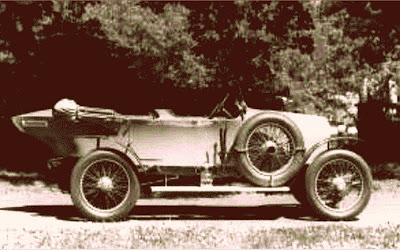
Labels: Audi, Audi Alpensieger, Wallpapers







